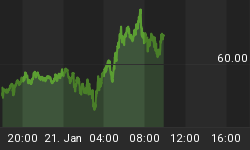After 10 weeks of being "all in", the bulls have retreated leaving investor sentiment with a neutral reading this week. This seems kind of odd as you would think that lower prices would be welcomed by those of bullish persuasion. Oh well! The "sure thing" has turned out not to be a "sure thing", and those who waited for the all clear are either back on the sidelines or have positions underwater. As expected (most of the time), extremes in bullish sentiment did not pan out for the bulls as the S&P500 is lower than 10 weeks ago. The current neutral reading implies no real edge from a sentiment perspective, but going forward it still is and always has been my contention that investor sentiment must turn bearish (i.e., bull signal) and key support levels must be broken before a new trading rally can start. If this doesn't happen, then it will be the same old story of quick rallies and sudden sell offs ala March to October, 2007. In hindsight, that was a market top, but it wasn't confirmed until the first bull signal (i.e., when investor sentiment turned bearish) failed to lead to a meaningful bounce.
The "Dumb Money" indicator (see figure 1) looks for extremes in the data from 4 different groups of investors who historically have been wrong on the market: 1) Investor Intelligence; 2) Market Vane; 3) American Association of Individual Investors; and 4) the put call ratio. The "Dumb Money" indicator is neutral.
Figure 1. "Dumb Money" Indicator/ weekly
The "Smart Money" indicator is shown in figure 2. The "smart money indicator is a composite of the following data: 1) public to specialist short ratio; 2) specialist short to total short ratio; 3) SP100 option traders. The "Smart Money" indicator is neutral.
Figure 2. "Smart Money" Indicator/ weekly
Figure 3 is a weekly chart of the S&P500 with the InsiderScore "entire market" value in the lower panel. From the InsiderScore weekly report we get the following: "Buyers have come out in numbers (especially following the "flash crash", but they're not putting enormous amounts of money to work; and, despite taking a couple off days off, sellers are still the dominant force when you eliminate the Financial sector from the equation."
Figure 3. InsiderScore/ weekly "entire market" value
Figure 4 is a weekly chart of the S&P500. The indicator in the lower panel measures all the assets in the Rydex bullish oriented equity funds divided by the sum of assets in the bullish oriented equity funds plus the assets in the bearish oriented equity funds. When the indicator is green, the value is low and there is fear in the market; this is where market bottoms are forged. When the indicator is red, there is complacency in the market. There are too many bulls and this is when market advances stall.
Currently, the value of the indicator is 57.89%. Values greater than 58% (arbitrarily chosen) are associated with market tops, and the red dots over the price bars indicate such. This time was NOT different.
Figure 4. Rydex Total Bull v. Total Bear/ weekly
Improve your market timing. TheTechnicalTake now offers Premium Content on a daily basis for a nominal yearly fee. This unique data set will show you which way investors (i.e., bull market geniuses) are leaning. It is independent and original market analysis. To view a recent report click: REPORT.
To subscribe, please click: SUBSCRIBE















